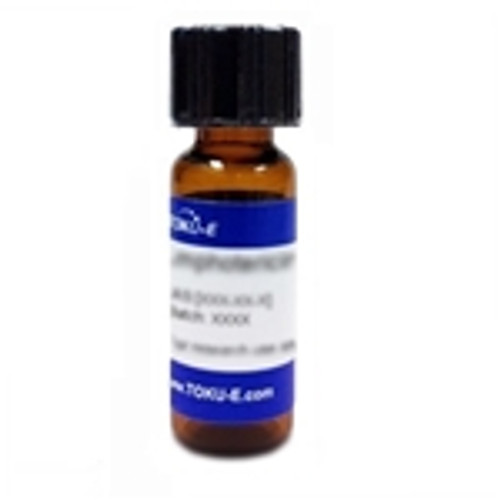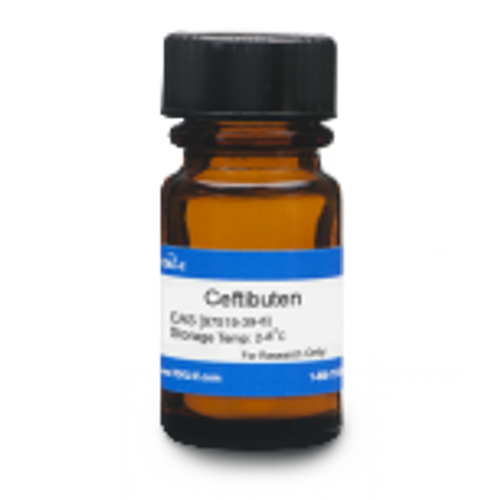Doripenem Hydrate is a β-lactam antibiotic of the carbapenem class, specifically a 1-β-methyl carbapenem. It is effective against extended spectrum β-lactamase (ESBL) producing Enterobacteriaceae, a microbe resistant to many first line β-lactam antibiotics and certain cephalosporins. Doripenem Hydrate is a precursor for Doripenem commonly used as an analytical reference standard. The compound can be used in forensics and toxicology applications. Techiques to determine if Doripenem is present include include high-performance liquid chromatography (HPLC), high performance thin layer chromatography (HPTLC) for bulk formulations, liquid chromatography combined with tandem mass spectrometry (LC-MS/MS) for muscle samples, capiillary electrophoresis coupled to ultraviolet detection and micellar electrokinetic chromatography (MEKC) with UV detection for pharmaceutical samples.
Doripenem Hydrate is sparingly soluble in aqueous solution.
| Mechanism of Action |
β-lactams interfere with PBP (penicillin binding protein) activity involved in the final phase of peptidoglycan synthesis. PBP’s are enzymes which catalyze a pentaglycine crosslink between alanine and lysine residues providing additional strength to the cell wall. Without a pentaglycine crosslink, the integrity of the cell wall is severely compromised and ultimately leads to cell lysis and death. Resistance to β-lactams is commonly due to cells containing plasmid encoded β-lactamases; however, carbapenems, including Doripenem, are highly resistant to β-lactamases. Doripenem shows a marked affinity for PBP2 and PBP4 in E. coli MC4100, for PBP2 and 3 in P. aeruginosa PA01 and 27853, and for pBP1 in S. aureus. Dorepenem is resistant to most beta-lactamases produced by Gram-negative and Gram-positive microorganisms, including penicillinases and cephalosporinases (Alvarez-Lerma, 2009). Various resistance mechanisms have been identified, including loss of porin OprD, the expression of efflux systems, the production of carbapenemases, and the alteration of certain PBPs (Zhanel et al, 2007). |
| Spectrum | Doripenem Hydrate is a broad spectrum antibiotic targeting a wide range of Gram-positive and Gram-negative bacteria including Pseudomonas aeruginosa. Structurally and activity-wise, it is similar to meropenem and it matches meropenem's activity against Gram-negtive bacteria. It matches imipenem or ertapenem activity against Gram-positive bacteria. |
| Microbiology Applications | Doripenem is commonly used in clinical in vitro microbiological antimicrobial susceptibility tests (panels, discs, and MIC strips) against Gram-positive and Gram-negative microbial isolates. Medical microbiologists use AST results to recommend antibiotic treatment options. Representative MIC values include:
|
| Molecular Formula | C15H24N4O6S2•H2O |
| References |
Alvarez-Lerma F, Grau S and Gerrandez O (2009) Characteristics of Doripenem: A new broad-spectrum antibiotic. Drug. Des. Devel. Ther. 3:173-190 PMID 19920933 Kurien J, Jayasekhar P and John J (2014) A validated HPTLC method for the determination of Doripenem in pharmaceutical dosage forms. Int. J. Pharm. Sci. Rev. Res. 27(1):317-321 Pitout JD, Sanders CC, Sanders WE (1997) Antimicrobial resistance with focus on beta-lactam resistance in Gram-negative bacilli. Am. J. Med 103:51 Michalska K, Cielecka-Piontek J, Pajchel G, Tyski S (2013) Determination of biapenem in a medicinal product by micellar electrokinetic chromatography with sweeping in an enhanced electric field. J Chromatogr A. 1282:153-160 PMID 23419350 Zhanel G et al (2007) Comparative review of the carbapenems. Drugs 67(7):1027-1052 PMID 17488146 |
| MIC | Bacteroides distasonis| 0.25 - 1|| Bacteroides fragilis| 0.125 - 16|| Bacteroides ovatus| 0.25 - 4|| Bacteroides thetaiotaomicron| 0.12 - 2|| Bacteroides vulgatus| 0.125 - 1|| Bilophila wadsworthia| 0.03 - 0.12|| Burkholderia cepacia| 0.5 - 256|| Clostridium bifermentans| 0.06 - 0.125|| Clostridium cadaveris| 0.03|| Clostridium clostridioforme| 1|| Clostridium difficile| 0.5 - 4|| Clostridium innocuum| 1|| Clostridium paraputrificum| 0.25|| Clostridium perfringens| ≤0.016 - 0.06|| Clostridium ramosum| 0.5 - 1|| Clostridium sordellii| 0.03|| Clostridium spp.| 0.03 - 4|| Finegoldia magna| 0.06 - 0.125|| Fusobacterium mortiferum| 0.125 - 1|| Fusobacterium necrophorum| ≤0.016 - 0.25|| Fusobacterium nucleatum| ≤0.016 - 0.03|| Fusobacterium spp.| 0.03 - 1|| Fusobacterium varium| 0.06 - 1|| Gram-Positive Anaerobic Cocci| 0.03 - 0.25|| Micromonas micros| ≤0.016 - 0.125|| Nonsporing gram-positive rods| 0.03 - 8|| Peptoniphilus asaccharolyticus| ≤0.016 - 0.125|| Peptostreptococcus anaerobius| 0.125 - 2|| Porphyromonas asaccharolytica| ≤0.016 - 0.03|| Porphyromonas gingivalis| ≤0.016|| Porphyromonas levii | 0.03|| Porphyromonas spp.| 0.03 - 4|| Prevotella bivia| 0.03 - 4|| Prevotella buccae| 0.06 - 0.125|| Prevotella corporis | 0.03 - 0.06|| Prevotella denticola| ≤0.016 - 0.25|| Prevotella disiens| 0.03 - 4|| Prevotella intermedia| ≤0.016 - 0.125|| Prevotella melaninogenica| ≤0.016 - 0.25|| Prevotella nigrescens| 0.03 - 0.062|| Prevotella oris| 0.03 - 0.5|| Prevotella spp.| 0.03 - 0.25|| Pseudomonas aeruginosa| 0.06 - 512|| Sutterella wadsworthensis| 0.06 - 32|| |








